Finally, something truly creepy and scary for Halloween week.
At some point during 2000, I read a book called A Twist at the End: A Novel of O. Henry and the Texas Servant Girl Murders of 1885 by Steven Saylor. I’m not entirely sure how I came to have this book because I’m not really one for historical fiction, but once I learned that the book was indeed based on real events, I became obsessed with the Servant Girl Annihilator case. As most friends I had at the time can tell you, I pretty much sent a copy of this book to anyone who showed even the slightest interest in it. I went on a “ghost tour” that took me on a walk late at night to visit the locations of some of the murders. It was on this tour that I learned about the “Moonlight Towers,” one of which stood at the end of the street where Mr. Oddbooks and I lived at the time, a nearly useless anachronism that seemed pointless to me until I learned their origin.
Much of what I am going to share here is data I have rattling around in my brain, but I will include a list of links at the end of this article for those who may want to read more about this interesting case than just what I remember.
The moniker “Servant Girl Annihilator” is actually both a flippant and misleading moniker for the person or persons behind the murders that occurred in Austin, Texas in 1884-1885. The name comes from a line William Sydney Porter, aka “O. Henry” put in a letter to a friend, describing the events in Austin in the summer of 1885. In a bitchy little comment worthy of Oscar Wilde, Porter snarked that Austin was terribly boring but the attacks from the “Servant Girl Annihilators” made things interesting at night. This moniker is misleading because men, boyfriends/common law husbands living with some of the female victims were also attacked, and because the last two women killed were not servants, but “respectable” married women.
But most of the victims were indeed women and most of them were black servants. Here is a list of the victims, as well as what was done to them. Most readers of this site are hardy people, but if you are new here, the content that follows may be a bit upsetting.
12/30/1884: Mollie Smith, age 25, was found bludgeoned outside the outhouse at the home where she worked. She had suffered a gory wound to her head and her nightdress was torn and bloody, indicating that she was raped, or “outraged” using the parlance of the time. Her boyfriend, Walter Spencer (also called Walter Spence in some accounts), who lived with her in a room at the back of the home where she was employed, was seriously injured. He had been struck in the head with an axe in the bed where he and Mollie slept and the room showed signs of a bloody struggle.
5/6/1885: Eliza Shelley, who worked for a former state senator, was found murdered in the small cabin behind the main house where she lived with her three children. Like most of the SGA victims, she had been struck in the head with an axe, cutting her head almost in two. A metal implement had been driven into her skull as well. She had been hit hard and fast while sleeping, was removed from the bed after the attack, and raped. It is believed, horribly, that one of her children was awake for the attack and was in the same room when his mother was raped.
5/22/1885: Irene Cross bled to death after being attacked by a man with a knife outside of the small house she lived in on the property of her employers. She died from severe head trauma and her shoulder had been struck with a sharp implement to the point that her arm was almost severed from her body. She lived long enough for the press to be able to question her and one journalist reported that she looked for all in the world like she had been scalped.
8/30/1885: This is the murder I find the most upsetting. Eleven year old Mary Ramey was found in a “wash house.” Her skull had been pierced with an iron bar (in what sounds like a lobotomy) and she was raped. Her mother, Rebecca Ramey, had been bludgeoned in her bed before Mary was attacked and raped. Rebecca managed to survive the attack but could recall nothing of what happened to her and her child that evening.
9/28/1885: In an MO that echos the attacks on the Rameys, Orange Washington, the common law husband of Gracie Vance, was killed by an axe blow to the head as he slept. But the killer had more than one extra person to deal with. Two women, Lucinda Boddy and Patsey Gibson, were staying with Gracie and Orange that evening, and they were both attacked as well. Lucinda was struck in the head with the axe and then raped. She was conscious for the “outrage” against her but mercifully passed out when it was over. Patsie received several blows to the head and face with the axe but she too survived. With Orange, Lucinda, and Patsey dispatched, the killer focused on the woman who was likely the focus of the attack. He struck Gracie with the axe in order to disable her, dragged her to the stables wherein he bludgeoned her until her head was little more than goo. Sources vary on whether or not she was a victim of sexual “outraged,” but the state of her body makes it seem like she was raped. This attack has left SGA-ologists to speculate that there was more than one man attacking servants.
12/24/1885: Respected white mother, Susan Hancock, was murdered in a manner that combined the methods used in previous attacks. She was found behind her house, dead from a head wound from an axe. A thin piece of metal was also found in her head. She was raped. She had been attacked in the house and dragged from her bed as her husband Moses dozed in a chair in another room.
12/24/1885: Eula Phillips, nicknamed Luly, was found naked in the alleyway behind her home. She had received an axe wound to the head and had been raped. Her husband, James Phillips, and her son, James Jr, were found in the same bed, James Sr with an axe wound to the head. Curiously, the little boy was not hurt in any way and had been given an apple. James Sr survived.
And then it ended. All that mayhem in one year and then it ended as quickly as it began. (Some SGA scholars believe that there were three additional victims, Clara Strand, Christine Martensen, and Clara Dick. I believe these three women were victims of wholly unrelated crimes, but amongst the SGA-ologists, there is debate on this topic. If anyone has any differing opinions, feel free to share them.)
Here’s a map that shows the victims’ locations, mostly so fellow Austinites can see where it all happened:
During the height of the murders, it was believed that the killer had to be a black man, and at least one lynching was averted by the quick action of a white homeowner. Walter Spencer, the boyfriend of victim Mollie Smith, was arrested, tried and acquitted of Mollie’s murder. Later, strangely, the husbands of the Christmas Eve murder victims were arrested for killing their wives. Moses Hancock and James Phillips were charged, inexplicably, with raping and murdering their wives, using the same MO on the same night, and, in the case of Phillips, smashing himself in the head with an axe. The cases against both men were pretty shaky.
Moses Hancock was arrested because the police found a months-old letter from Susan to Moses, wherein she told him she was tired of his drinking and did not want to live with it anymore. The prosecuting attorney said that Moses had gotten tanked on Christmas Eve and had come home to an angry wife, threatening to leave him. They claimed he killed her to keep her from leaving. The case against Moses was ruined when Susan’s daughter revealed her mother never had the courage to show her husband the letter and that Moses had never seen it before the attack.
But it was the arrest of James Phillips that made this case seem lurid, giving Steven Saylor the rough outline for his historical novel about the case. I know a lot of research went into the case against James Phillips but it still all seems so unlikely to me because it all hinges on the accusations against a seventeen year old married girl. James Phillips was evidently quite a rake when Eula married him in 1883 when she was fifteen. Yes, fifteen. James was abusive, and according to Eula’s sister, after one drunken fight Eula asked her sister to take her to the home of a local bordello madam named Fanny Whipple.
Eula, already having born James one son found herself pregnant again in 1885 and it was rumored that she tried to abort the baby. She then evidently became a prostitute, working out of the home of a madam named May Tobin. It was said Eula was at that house, a place where high class prostitutes met their clients, on Christmas Eve. During James Phillips’ trial, all kinds of names were bandied about as potential clients or even lovers who courted Eula during her short marriage. The prosecutors alleged that James became aware of his wife’s infidelities, raped and killed her, staged the body outside the home, gave his little son an apple and placed him in the same bed as his father, and then whacked himself but good with the axe so as to make himself seem like a victim. James, somehow, was convicted but was sentenced only to seven years. His sentence was later overturned on appeal.
Think about this with me for a minute. I mean, yes, all kinds of people said all kinds of things about Eula Phillips. None of it seemed to have any sort of physical evidence to back it up, but it was all so tantalizing, right? Young, extremely beautiful girl, famous and powerful boyfriends courting her or paying for her sexual favors at a house of assignation…
But Eula was 15 when she got married. During ages 15-17, she bore one son and was rumored to be pregnant again, but terminated it with the help of noxious herbs. She somehow managed to meet one madam, caught the eyes of several powerful men who wanted to have sex with her or woo her, managed to meet a second madam and become a prostitute. All by the age of 17. Eula came from a respectable family. How she managed to find, in 19th century Austin, access to two madams, numerous men of power, and decided to accept money for sex despite her upbringing and her status as a married woman, is beyond me. I’ve often wondered how much truth there was in the accusations against Eula, mainly levied against her in the attempt to convict her husband of her murder.
I guess it could have happened that way. I guess Eula could somehow have managed to live such a sordid life as a teenager from a good family in Austin during 1884-1885, but it just never had the ring of truth to it for me. Bear in mind that very few people believe as I do, that Eula was the victim of a smear campaign orchestrated by a desperate attorney with money to spend bribing sex workers into lying about a dead, married, teenage mother.
At any rate, whether or not Eula was ever a prostitute or a wandering married woman, no one else was ever brought to trial for the SGA murders.
There is a lot more to read about regarding the investigation itself, but it is not anything that interests me overmuch. With few exceptions, most criminal investigations in old town Texas were complete messes, and the SGA murders were no exception.
I must also mention this element that really interested me about this case: the Austin Moonlight Towers. The Moonlight Towers are primitive electric street lights that were erected in 19th century Austin, in particular haste in 1885, as the town tried to ensure at least basic light covering at night on dark roads. I used to live in an old house on the corner of Pearl and 22nd Streets (the old house was razed for student condos) and would pass the Moon Tower on 22nd and Nueces and wonder what the point was in having such a dim street light. When I learned that tower was likely the result of the SGA murders, the Moonlight Tower took on, well, a different light for me. Orange Washington and Gracie Vance were killed one block and two streets over from where I used to live. I wondered if the Moonlight Tower actually made the people in that general area feel safer somehow. A blog at Austin Explorer has a great pic of the Moonlight Tower on 22nd and Nueces.
Lots of people like to postulate that the SGA murders were committed by the same person responsible for the Jack the Ripper murders. Most notably, the theory that one of the suspects, the Malay Cook, left Austin immediately after the Christmas Eve assaults on Susan Hancock and Eula Phillips and landed in London just in time to start assaulting prostitutes. This is certainly interesting to think about, but ultimately it is a load of pants. One seldom sees serial murderers change their modus operandi so radically.
Saucy Jack, with one exception, attacked white prostitutes outdoors in a specific neighborhood. He mutilated them in a ceremonial manner that meant something to him, especially in the case of Catherine Eddowes, whose kidney was sent in to taunt the press. None of his victims showed any sign of rape. He did attack Mary Kelly inside her room, and the end result was a completely mutilated body. The mutilations seemed to be the reason for the attacks, prostitutes the victim of choice likely due to the fact that Jack the Ripper had plenty of access to those high-risk victims.
The SGA’s attacks all ended in rape. The rapes seem to be the end goal of the attacks, demonstrated by the fact that victims that the SGA was uninterested in raping were dealt blows meant to incapacitate them, though sometimes the blows did kill them. The victims who were raped often showed signs of overkill, but it also seems like their head attacks were meant to render them helpless during the attacks. In fact, the attacks wherein the victims showed signs of having metal rods thrust into their heads strike me as suffering brain damage that was meant to leave them unable to fight back but not to necessarily kill them outright. This is unpleasant to contemplate but the SGA seems to me to be entirely more sadistic than Jack the Ripper, as well as engaging in a victim-pool far riskier for a killer – servant girls and married women inside their homes. While it can be argued that killing mostly black people insulated the SGA from the same level of scrutiny he would have received with a wholly white victim pool, the fact remains that the SGA entered homes wherein people other than the victim resided, generally adjacent to the homes of white employers. And bear in mind that the SGA crossed victim pools, attacking white servants, black servants and wealthy white women. Jack the Ripper and the SGA were wholly different killers.
When I first read about the SGA murders, I wanted to track down their headstones at Oakwood Cemetery, but it wasn’t until 2008 that I first went looking. I was spurred into action on a message board when a fellow poster revealed that the Susan Hancock and Eula Phillips stones had been stolen. I later came to realize this was only half true, though I did find some tantalizing clues as to where one of them might be interred.
Researching who was buried at Oakwood was simple enough. I easily found the plot locations for Mollie Smith, Eliza Shelley, Irene Cross, Mary and Rebecca Ramey, Gracie Vance, Orange Washington, Susan Hancock (as S.C. Hancock) and Eula Phillips (in the record I encountered, her name was misspelled as “Philipps). That all of these victims were interred in Oakwood is not in question. They are there somewhere. But I could only find two stones. I am unsure if the reason for this is because ghouls and vandals raided the smaller stones they could carry, but this is sheer speculation because I’ve never seen pictures of the stones that I myself did not take (not that they are not out there somewhere but I haven’t looked in a while). Mostly I think the stones for the black victims are missing because “colored” cemeteries are not maintained well, especially those founded within 20 years after the end of the Civil War, and that the stone for Eula Phillips was either stolen or destroyed by vandals.
People reported having seen Eula’s stone in the Phillips family plot but after 2002 people reported that they could no longer find it. Similar reports were made about the stone for Mary Ramey – Mary’s stone is now gone as well.
I didn’t give up easily. Like so many of my obsessions that I worry until I wear them out, I cannot explain why I was so driven to find the gravestones of these murdered people, but I was. I walked the entire “colored” cemetery three times but couldn’t find anyone but Rebecca Ramey. I crawled the entire sections wherein Susan Hancock and Eula Phillips were supposedly buried, but never could find Eula. I dragged Mr Oddbooks back with me and asked him to walk behind me and make sure I missed nothing. If I did miss anything, he missed it, too.
However, I can say that the person who announced that the Susan Hancock stone was gone was wrong, or at least he was as of the summer of 2008. I suspect that because her stone was under her initials, S.C., rather than Susan, people missed her. Also adding to the difficulty is that her stone was broken and flat in the dirt. If I hadn’t had the exact plot number, I could have missed it, too.
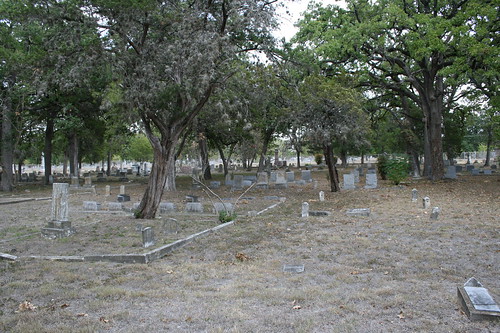
Here’s the general area where Susan Hancock was buried. Roughly in the center of the photograph, near the forefront, you can see a stone lying flat. That is Susan’s stone.
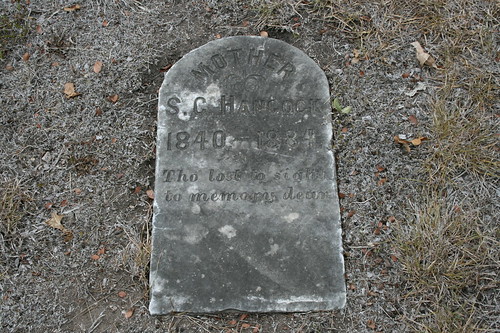
Here’s a closer look at Susan Hancock’s stone. I no longer give directions or write out plot areas for the locations of any famous or notorious graves. People genuinely interested in historical investigations will find this information on their own and those who just want to trash the cemetery don’t deserve any help.
Rebecca Ramey’s stone is heavy and solid and not the sort of stone a vandal or a thrill-thief could easily harm or carry away, and it’s also too heavy to move for ease of maintenance. Those are the two reasons I think it is still there.
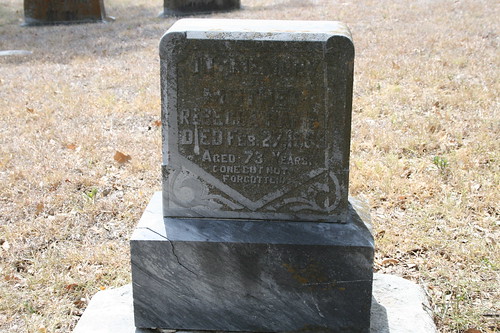
This is a truly dreadful picture but if you click on my Flickr entry, you can select larger sizes and get a better idea of what the stone looks like. Compared to some of the thinner stones, hand carved and flimsier stones, it is clear that Rebecca’s kin paid to have a substantial marker for this woman who lost a child to unspeakable violence and who herself survived a near-lethal attack.
Once upon a time, Mary Ramey had a faded stone somewhere near her mother’s stone. As of the summer of 2008, I could not find it. Three times through the “colored” cemetery and I couldn’t find it and Mr Oddbooks could not find it, either. Either it’s too faded to read or it’s gone.
There were tantalizing clues about where Eula may have been, but it is important to note that my clues are outside the Phillips plot, and Jeanine Plumer, the grande dame of SGA-knowledge, said it was in the Phillips plots when it was still extant. I found a foot stone near the Phillips plots, placed inside a completely unrelated grave.
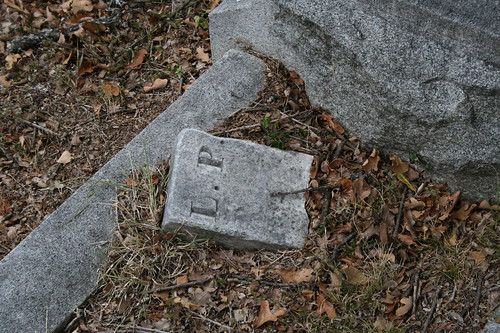
No way of knowing who this footstone belonged to but there was no grave within 100 feet or so with a deceased with the initials of LP. However, there were more than a few people in this cemetery who had “LP” for their initials.
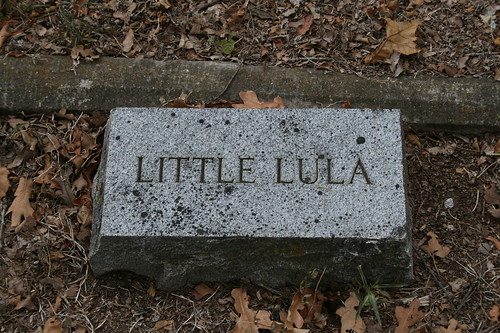
I also found this stone, also nowhere near the Phillips plots. Eula’s nickname was Luly, and Lula doesn’t seem too far off from “Luly,” and she died at 17. I checked every Eula and Lula buried in Oakwood. Interestingly, there are two Lulas with surnames that began with a “P.” There was also another Lula who died in her late teens. So there is no way of knowing who this particular footstone belongs to, but it was interesting finding it out of place during this specific investigation.
A lot of sentimental people make a lot out of the fact that the victims of the same killer(s) ended up in the same cemetery, as if being roughly near each other in the afterlife, white ladies of the house and black servants, bonded them after their common shared experiences of violence. I guess that is one way to look at the situation but, at the same time, their common burial ground just sort of reinforces the cultural norms of the time. The black servants ended up in a crappily-maintained section of the cemetery, their bodies lost to time. The matronly white victim got her stone but ended up more or less overlooked and broken in her section of Oakwood. And Eula Phillips, the seventeen year old mother made glamorous and seedy with rumors of liaisons and prostitution is all anyone really remembers. Artifacts related to her are serial killer holy grails and her story, her vaguely unbelievable but truly salacious story, propels the legend of the Servant Girl Annihilator to this day.
Here are some sources to find out more about this case:
The best article I’ve read is Skip Hollandsworth’s piece in Texas Monthly.
The Servant Girls Murders site has done an excellent job of researching the history of the victims, as well as the crimes themselves.
The always reliable Crime Library has a good discussion of the crimes.
And of course, check out Steven Saylor’s book, which I link to at the beginning of this article.